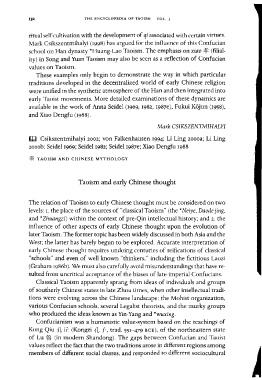Page 172 - The Encyclopedia of Taoism v1_A-L
P. 172
132 THE ENCYCLOPEDIA OF TAOISM VOL. 1
ritual self-cultivation with the development of qi associated with certain virtues.
Mark Csikszentmihalyi (1998) has argued for the influence of this Confucian
school on Han dynasty *Huang-Lao Taoism. The emphasis on xiao $: (filial-
ity) in Song and Yuan Taoism may also be seen as a reflection of Confucian
values on Taoism.
These examples only begin to demonstrate the way in which particular
traditions developed in the decentralized world of early Chinese religion
were unified in the synthetic atmosphere of the Han and then integrated into
early Taoist movements. More detailed examinations of these dynamics are
available in the work of Anna Seidel (1969, 1982, 1987e), Fukui K6jun (1958),
and Xiao Dengfu (1988).
Mark CSIKSZENTMIHALYI
m Csikszentmihalyi 2002; von Falkenhausen 1994; Li Ling 2000a; Li Ling
2000b; Seidel 1969; Seidel 1982; Seidel 1987e; Xiao Dengfu 1988
* TAOISM AND CHINESE MYTHOLOGY
Taoism and early Chinese thought
The relation of Taoism to early Chinese thought must be considered on two
levels: I. the place of the sources of "classical Taoism" (the *Neiye, Daode jing,
and *Zhuangzi) within the context of pre-Qin intellectual history; and 2. the
influence of other aspects of early Chinese thought upon the evolution of
later Taoism. The former topic has been widely discussed in both Asia and the
West; the latter has barely begun to be explored. Accurate interpretation of
early Chinese thought requires undoing centuries of reifications of classical
"schools" and even of well-known "thinkers," including the fictitious Laozi
(Graham 1986b). We must also carefully avoid misunderstandings that have re-
sulted from uncritical acceptance of the biases of late-imperial Confucians.
Classical Taoism apparently sprang from ideas of individuals and groups
of southerly Chinese states in late Zhou times, when other intellectual tradi-
tions were evolving across the Chinese landscape: the Mohist organization,
various Confucian schools, several Legalist theorists, and the murky groups
who produced the ideas known as Yin-Yang and *wuxing.
Confucianism was a humanistic value-system based on the teachings of
Kong Qiu {L rj·. (Kongzi {L (-, trad. 551-479 BC E), of the northeastern state
of Lu ~~ (in modern Shandong). The gaps between Confucian and Taoist
values reflect the fact that the two traditions arose in different regions among
members of different social classes, and responded to different sociocultural

